
If pics don't appear,right click on mouse,click show pics

![]()
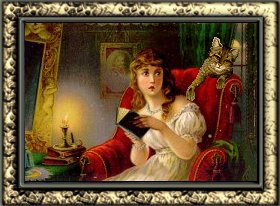


Many springtimes ago, according to an old Polish legend, tiny kittens had been chasing butterflies at the river's edge and fell in. The mother cat, helpless to save them, started crying. The willows at the river's edge swept their long graceful branches into the water - the kittens gripped on tightly to the branches and were rescued.
Each springtime since, goes the legend, willow branches sprout tiny fur-like buds where the tiny kittens once clung.
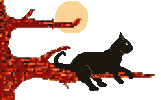
The fox was boasting to the cat of his clever devices for escaping his enemies. "I have a whole bag of tricks which contains 100 ways of escaping my enemies," he said. "I have only one," said the cat, "but I can generally manage with that." Just at that moment they heard the cry of a pack of hounds coming towards them, and the cat immediately scampered up a tree and hid herself in its branches.
"This is my plan," said the cat. "What are you going to do?" The fox thought and thought as he looked in his bag of tricks, and while he was debating the hounds came nearer and nearer. At last the fox in his confusion was caught by the hounds and soon killed by the huntsmen. Miss Puss, who had been looking on, said: "Better one safe way than 100 on which you can not reckon."
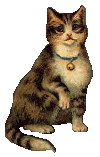
All of the mice met in council to discuss the best way to secure against attacks of the cat. After several suggestions were debated, a mouse of experience and standing got up and said: "I think I have hit upon a plan which will ensure our future safety." We will fasten a bell around the neck of our enemy, the cat, which by its tinkling will warn us of her approach."
As the proposal was being applauded, a mouse who was even wiser stood up on his feet and said: "It is easy to propose impossible solutions. I agree that it is an admirable plan, but who is going to bell the cat?" (aesop fable)
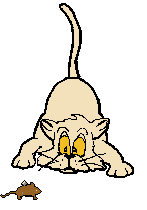
As legend goes, the cat once caught a mouse and was about to eat the tasty little morsel when the mouse chided the cat for her bad manners. "What?" cried the mouse, "You're going to eat me without first washing your face and hands?"
The mortified cat immediately dropped the mouse and began washing, and the clever little mouse promptly scooted off.
Ever since, cats have not washed up before dinner.

Cats can forecast the weather. They predict the wind by clawing at carpets and curtains. Rain is highly likely when a cat busily washes its ears.
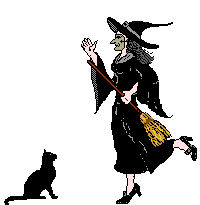
In mythology, the cat was believed to have a great influence on the weather. Witches who rode on storms took the form of cats. The dog, an attendant of the storm king Odin, was a symbol of wind. Cats came to symbolize down-pouring rain, and dogs to symbolize strong gusts of wind.
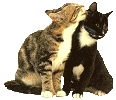
Some people believe that if a cat washes its face and paws in the parlor, company's coming.

If a cat continually looks out a window on any day, rain is on the way.
Some cats can predict earthquakes (actually, there is some truth in this "folklore".
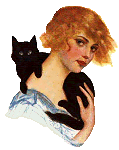
When a girl living in the Ozark Mountains received a marriage proposal and was uncertain whether to accept, she folded and placed 3 hairs from a cat's tail into a paper under her doorstep. The next morning, she would unfold the paper to see if the hairs had formed themselves into a Y or N before answering her suitor.

"If a cat washes her face in front of several persons, the first person she looks at will be the first to get married."
Sailors used cats to predict the voyages they were about to embark on. Loudly mewing cats meant that it would be a difficult voyage. A playful cat meant that it would be a voyage with good and gusty winds.
If early American cats sat with their backs to the fire, the owners knew it foretold a cold snap.
A cat sleeping with all four paws tucked under means bad weather is coming.
One Roman dream interpretation was that dreaming of being badly scratched by a cat foretold sickness and trouble.
French peasants thought that black cats could find buried treasure, if they followed a specific ritual: find an intersection where 5 roads connected, then turn the cat loose and follow him.
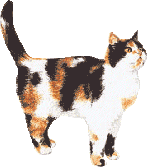
Tortoiseshell cats were believed to be able to see into the future and could give the gift to a lucky child in the family.

The Pennsylvania Dutch would place a cat in an empty cradle of a newlywed couple. The cat was supposed to grant their wish for children.
In Scandinavia, the cat stood for fertility.
The Hindu also believed the cat was the symbol for childbirth.
If you kick a cat, you will develope rhuematism in that leg.
If you are a farmer and kill a cat, you can expect your cattle to die mysteriously.
If you drown a cat, you will fall victim to a drowning.

Sailors believed that the worst possible cat-related act, guaranteed to raise a storm and bring bad luck of all sorts, was to throw the cat overboard.

English schoolchildren believed seeing a white cat on the way to school was sure to bring trouble. To prevent the bad luck, they were to spit or turn around completely and make the sign of the cross.

Charles I, King of England, owned a black cat that he felt brought him luck. He was so afraid of losing it that he had it guarded day and night. The day after the cat died, he was arrested.
A cat sneezing is a good omen for everyone who hears it.
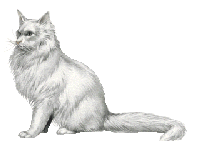
Dreaming of a cat is sometimes regarded as a sign of bad luck in the future. On the other hand, American folklore has it that dreaming of a white cat is good luck.
In France, it is believed that if you find one white hair on a black cat, Lady Luck will smile upon you.
In the early 16th century, a visitor to an English home would always kiss the family cat to bring good luck.
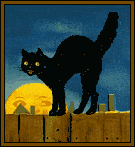
Fishermen's wives kept a black cat at home to prevent disaster at sea.

If a cat ran ahead of a sailor to the pier, it was believed that would bring good luck; if the cat crossed his path, it would bring bad luck.
It is bad luck to see a white cat at night.

In Ireland, having your moonlit path crossed by a black cat was thought to foretell death in an epidemic.
In France, there is a superstition that it is bad luck to cross a stream carrying a cat.
When you see a one-eyed cat, spit on your thumb, stamp it in the middle of your palm, and make a wish. The wish will come true.
In Normandy, seeing a tortoiseshell cat foretold death by accident.
Early American colonists believed that a broth made from boiling a black cat would cure tuberculosis, but no one wanted to risk the bad luck that would befall them if they killed the cat.
A common folk cure for a stye on the eyelid was to rub it with the tail of a black cat.

In Transylvania, if a cat jumps over a corpse, the corpse will become a vampire.
Early Christians believed that if a cat sat on a grave, the buried person's soul was in the devil's power. Another belief was that if two cats were seen fighting near a dying person, or on the grave shortly after a funeral, the creatures are really the Devil and an Angel fighting for possession of the soul.

In the 16th century in Italy, it was believed that if a black cat lay on the bed of a sick man, he would die. However, they also believed that a cat will not remain in the house where someone is about to die--if the family cat refused to stay indoors, that was a bad omen.
Immigrants from Scotland believed that if a cat entered a room where a dead body was in state, the next person to touch the cat would be blinded. Therefore, the cat in such situations was immediately killed.
The folklore that a cat has 9 lives possibly came about because #9 is the "trinity of trinities" and was considered lucky.
A cat has 9 lives. For 3 he plays, for 3 he strays, and for the last 3 he stays. (An American and English Proverb)

In Japan, there is a myth that cats turn into super spirits when they die. According to the Buddhist religion, the body of the cat is the temporary resting place of the soul of very spiritual people.
Some people believe that cats engage in astral travel even in life.They also believe that if a cat adopts you, it will stay with you forever, even after death.
Cats were sacred to Isis, goddess in Egyptian mythology. Isis' and Osiris'daughter Bast was the moon goddess and goddess of cats, and was represented by a woman with the face of a cat.

The cats in her temple in the city of Bubastis wore heavily jewelled collars, were regarded as Gods and treated royally. Anyone who killed a cat was put to death. The cats were said to control the moon's movement, protect the dead, and had total authority over the royal houses at night because of their ability to see things that humans couldn't see in the dark.
Cats were so loved by the Egyptians that they sometimes mummified a mouse to accompany the cat into the afterworld.
King Osorkon, of the twenty-second dynasty, placed a white cat in the center of a magnificent temple and ritually endowed it with supreme power.
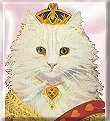
During excavations in the ruins of Tell-Basta(the former Bubastis), a graveyard with 300,000 mummified holy cats were discovered. Though many were sent to England and sold as fertilizer, a few were sent to museums.
Mohammed cut off the sleeve of his robe rather than disturb his cat from resting.

Norse legend tells of Freya, goddess of love and fertility, whose chariot was pulled by two black cats. Some versions of the tale claim they became swift black horses, possessed by the Devil. After serving Freya for 7 years, the cats were rewarded by being turned into witches, disguised as black cats.
Traits associated with cats include cleverness, unpredictability, healing and witchcraft, since in ancient times it was believed that witches took the form of their cats at night.
Folkore has it that if a witch becomes human, her black cat will no longer reside in her house.

It was largely in the Middle Ages that the black cat became affiliated with evil. Because cats are nocturnal and roam at night, they were believed to be supernatural servants of witches, or even witches themselves. Partly because of the cat's sleek movements and eyes that 'glow' at night, they became the embodiment of darkness, mystery, and evil, possessing frightening powers.
If a black cat walked into the room of an ill person, and the person later died, it was blamed on the cat's supernatural powers. If a black cat crossed a person's path without harming them, this indicated that the person was then protected by the devil.
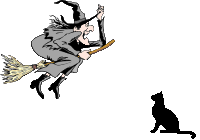
Often times, a cat would find shelter with older women who were living in solitude. The cat became a source of comfort and companionship, and the old woman would curse anyone who mistreated it. If one of these tormentors became ill, the witch and her familiar were blamed.

The phrase "It's raining cats and dogs" probably began at the time when drainage systems were inefficient and stray animals drowned. When finding them on the street, peasants thought they had fallen from the sky.
In ancient times, a criminal's punishment sometimes included having his tongue cut out; the tongue was fed to the King's pets. Hence, there is some historical truth to the phrase "cat got your tongue?"
Domesticated cats are not mentioned in the Bible.
An American superstition: When moving to a new home, put the cat in through the window, not the door, so that it will not leave.
Come with us and listen to the
Please sign our guestbook before you leave.
Also visit the nice people listed below.


| Site Map Purrfect Pets~Marvelous Meows |
